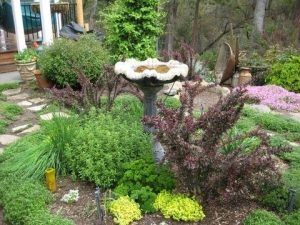Gardening with Grasses
Many gardeners think of grasses as “those plants in meadows and fields.” They seldom choose to add grasses, and especially native bunch grasses, to their gardens. And what a treat they are missing. Grasses don’t have showy flowers, interesting bark, or twisted branches, and their foliage doesn’t have bright fall color. So why, do you ask, should I plant native grasses? Because grasses add a subtle touch to gardens and may be used to unify garden sections. They add interest and texture throughout their growing season.
Native bunch grasses fall into two categories: warm season and cool season. By incorporating both types in your garden you will add interest all year long. Even when dormant, the grasses stand tawny and rigid, swaying in the wind, they add color and interest to the garden. Grasses may be cut back each year, but that should be done just before new growth starts. Cool season grasses are pruned in late fall and warm season grasses are pruned in late spring. Here are a few grasses to consider for your garden:
Deergrass (muhlenbergia rigens) and alkali sacaton (Sporobolus arroides) are large, warm season grasses. I planted three deergrass plants on a hill alongside our driveway nine years ago. Today the hillside is covered with this beautiful grass as we have allowed the tall (almost 4 feet) inflorescences to spread seed across the hill expanse. Both deergrass and alkali stay green all summer long. Their beige fall and winter color add a subtle hue to the landscape and snow clinging to the inflorescences can be quite striking.
Blue gamma grass (Bouteloua gracilis) also grows during summer. It forms small, fine-bladed clumps with inflorescences that resemble eyelashes and is an excellent bunchgrass for small garden spaces In hot, dry areas.
Purple three-awn (Aristida purpurea) is an intermediate-sized grass and has green foliage and flowers nearly all year ling. Its flowers have long, showy purple awns. Purple needlegrass (Nasella pulchra), and nodding needlegrass (nasella cernua) are smaller bunch grasses that fall into the cool season category. After the winter rains arrive, these grasses green up and develop needle-like inflorescences that shimmer in the sunlight. The needlegrasses and the purple three-awn do have a tendency to reseed around the garden, but their attractiveness makes it worthwhile to weed out the unwanted seedlings.
I also like the fescue species. Many of these grasses stay small and would be ideal for the smaller suburban garden.
Idaho fescue D(Festuca Idahoensis “Siskiyou Blue”), is silver-blue in color and makes a nice contrast to the green grasses.
California fescue (festuca californica) is a light green grass and is another re-seeder. I like to pot up the new seedlings and, once established, give them to friends or find new places for them in the garden. Some fescue speies stay quite small and have fine green blades. They are ideal for rock gardens or just tucked in close to a walkway where they can spill onto the path to soften the edges.
Pacific reedgrass (Calamagrotis nutkaensis). Although this grass prefers a coastal habitat, with regular water it does well at my 3,000 foot elevation, as well as in the Master Gardener demonstration garden in Sonora. It makes a substantial clump of erect, broad, flad inch-wide plumes. This grass will tolerate wet soils and some shade inland. This is a grass to use as a long-specimen plant or masses, to make an even more spectacular show.
The Master Gardener demonstration garden has a native grass and wildflower meadow that was planted three years ago. In the spring the wildflowers put on their show and the grasses (most mentioned in this article) take a back seat. But when the wildflowers are spent, the meadow comes alive with the grasses taking over and holding court. Come to an Open Garden Day (Saturday, April 2nd) to see the meadow and the several species of grasses before making a choice for your garden.
Carolee tries to have at least one specimen of grass in every garden bed. Most of her planting areas have at least two or three species of grasses.

